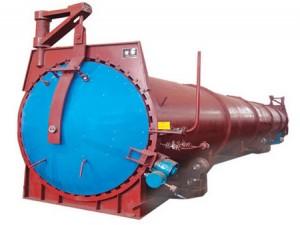There are many acceptable ways to cure rubber compounds. The process of vulcanizing, the cross linking of molecules within a rubber, uses 3 simple variables to achieve this. Changing any one of the three variables will affect how long it will take for the rubber to cure. Time, Temperature and Pressure.
The most common methods are the following:
- Steam Autoclave: A large vessel in which you can pressurize with the use of steam, or assisted by a compressor. You must be able to bring the vessel up to temperature in order to cure the rubber. Pro most rubber compounds are designed for steam autoclaves. The pressure reduces bubbles trapped in the rubber compound from expanding. Con you must sandblast the exterior of pipe after the cure due to the rust formed by the steel.
- Electric Autoclave: Also a pressure vessel but the pressure is derived using a compressor no steam is added. There are also electric elements as well as fan to circulate the hot air. This type of autoclave reduces the amount of steps required to finish a steel pipe. Pro no need to sandblast the exterior as the steel will not rust in this curing application. Con some rubber compounds manufacturers have chemical packages which require steam in order to vulcanize properly.
- Atmospheric Cure: This method of curing is generally the least desirable. But due to object size and shape it is necessary. Usually the pressure is atmospheric so the time to cure is usually extended to 9-12 hours depending on the tarp seal, steam source (HP of boiler) and thickness of rubber. Pro You can cure unusual shapes and large pieces. Con depending on how well the steam is dispersed throughout the cure some section may cure faster than others. Water can pool inside low lying rubber lined area’s. This pooled water can insulate the rubber and leave it uncured.
- Chemical Cure: This method is reserved usually for tanks or area’s that are too large to tarp. Some repairs can be done using this method. Special chemical cure compounds are to be used. The challenge with the chemical cure application is that the surface is what get’s affected the most by the curing chemicals. Pro you can cure large area’s that are difficult to tent. You can make repairs and cure the repair only. Con the chemical cure usually only affect a portion of the exterior of the rubber patch or surface leaving the balance of the rubber to cure over time on it’s own. You can get uneven wear.
- Microwave cure: Used in automotive or belt manufacturers. Pro can do inline continuous curing Con rubber cannot be attached to steel for this process.


Your mode of describing everything in this paragraph is truly fastidious, every one be capable of without difficulty understand it, Thanks a lot.|
Thank you for your feedback. It is a new blog and were happy to provide people simple information to help remove some of the mystery surrounding rubber lining.
Thank you very much we built this web site ourselves using Word press and a template called Hiero. We appreciate your feedback.
Wow! This blog loߋks just likе my old օne! It’s on a entirely dіfferent subject but it
has pretty much the same laʏout and design. Wonderful
ϲhoice of colors!
Thanks. As this is a WordPress template I’m sure a few people have blogs in this style.
What is the best curing method? – Rubber Lining
asifcvcscw
[url=http://www.g9ie398ai7c3xj7fyt06l99485b0wxj1s.org/]usifcvcscw[/url]
sifcvcscw http://www.g9ie398ai7c3xj7fyt06l99485b0wxj1s.org/
For rubber lining the best curing method is using an autoclave. Both the electric and steam autoclave crosslink the molecules ensuring the rubber liner will retain it’s final shape. The electric autoclave reduces the amount of steps required for finishing a product. So it would be considered a “Leaner process” but the resulting product will have the same performance characteristic as a steam autoclave.
Pretty! This was a really wonderful article. Thanks for supplying this information.
Thanks you! No problem.
Admiring the hard work you put into your site and detailed information you offer. It’s good to come across a blog every once in a while that isn’t the same unwanted rehashed material. Wonderful read! I’ve bookmarked your site and I’m adding your RSS feeds to my Google account. ddddgeggaeaaeagf